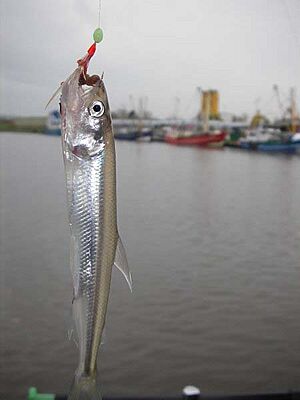European smelt facts for kids
Quick facts for kids European smelt |
|
|---|---|
 |
|
| Conservation status | |
| Scientific classification |
The smelt or European smelt (Osmerus eperlanus) is a type of fish found in the Osmeridae family. It's known for its unique smell, which is a bit like fresh cucumbers!
Contents
What Does a Smelt Look Like?
Smelts are usually about 15 to 18 centimeters (6 to 7 inches) long. Some bigger ones can grow up to 30 centimeters (12 inches). Their bodies are thin and a little flat on the sides.
Smelts have a slightly see-through body. Their back and sides are grey-green or pink. Their sides are bright silver. The tailfin has a dark edge. Smelts can live for up to six years. A special thing about them is their strong smell, which reminds people of fresh cucumbers.
Where Do Smelts Live and How Do They Grow?
Smelts are sea fish. They live in the coastal waters of Europe. You can find them from the Baltic Sea all the way to the Bay of Biscay. There's also a type of smelt that lives in freshwater. This kind is common in the big lakes of Northern Europe.
Smelt Spawning and Diet
Smelts gather in strong currents to lay their eggs over sandy areas. This happens from late February to March. The water temperature needs to be above 9 degrees Celsius (48 degrees Fahrenheit). A female smelt can lay as many as 40,000 eggs! After laying eggs, many smelts often die.
Smelts mainly eat small plankton crabs. They also eat tiny animals that live on the bottom of the water. Sometimes, they even eat their own young.
Smelt as a Tasty Food
Even though smelts are small, people really enjoy eating them. Usually, their head is removed before cooking. But the tail and bones are often left on because they are very soft. Smelt is generally eaten by hand. The fish is most often fried.
How Smelts Are Caught
During the time they lay eggs, smelts are easy to catch with nets. In the autumn, outside of this season, smelts can be found in harbors along the Baltic Sea coast. Here, they are caught using special lures.
A long time ago, people caught huge amounts of smelts in rivers. They even used washing baskets instead of nets! In Hamburg, Germany, there's an area called Stintfang, which means "smelt catch." This name shows how important smelts were there. In Lüneburg, a street with many pubs and restaurants is called Stintmarkt, also named after the fish.
In recent times, smelts were not caught much. This was because rivers were polluted, and not many smelts could be found. But now, river water quality has gotten much better. So, smaller fishmongers can catch many smelts again. Restaurants especially like to serve smelt as a special seasonal dish. Some smelt fishermen even run their own successful restaurants.
Smelt Dishes Around Europe
In North Germany, smelts are traditionally rolled in rye flour. Then they are fried in butter with bacon. People often eat them with roasted potatoes, potato salad, or apple sauce.
In the northern Russian city of Saint Petersburg, smelt is a famous local food. It's known there as koryushka. It's loved for its "cucumber" smell. Some say that the availability of koryushka was one reason Peter the Great chose to build St. Petersburg in that spot. In March and April, the smelt season begins. Many street sellers offer fresh smelts. You can easily find them by their cucumber smell! Some restaurants also feature smelt in March and April. Many local people cook smelt for dinner. The fish are rolled in wheat flour and gently fried.
Smelts can also be smoked. Or they can be rolled up and pickled, similar to how herring is prepared.
See also





